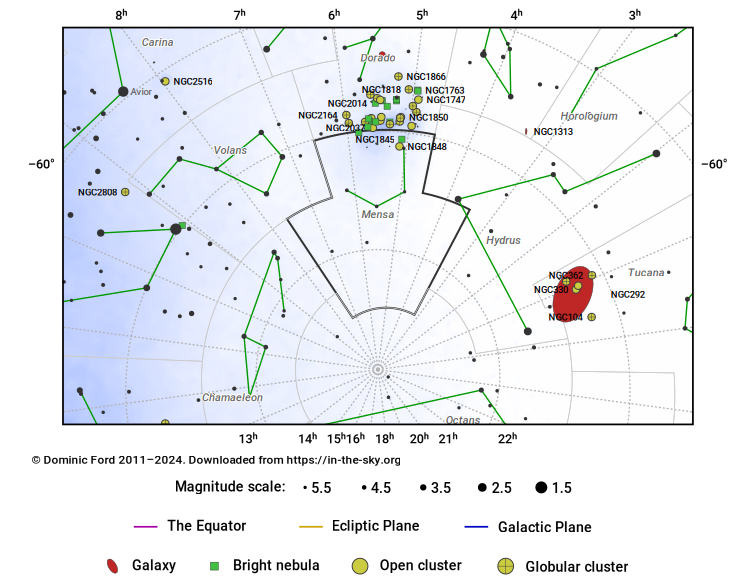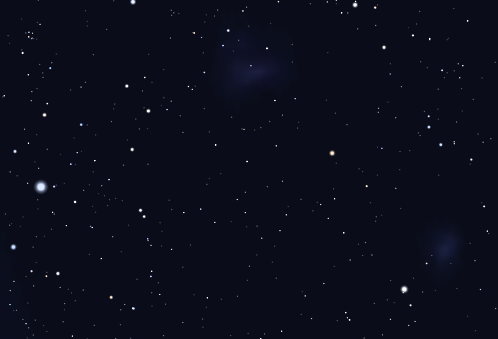The Constellation Mensa
Mensa is a small constellation which lies close to the south celestial pole. Across much of the southern hemisphere it is circumpolar, but it appears highest in the evening sky in the months around December.
The name ‘Mensa’ means ‘table’ and refers to Table Mountain, close to Cape Town. It is the only constellation to be named after a real geographic feature on Earth, and was created by Nicolas Louis de Lacaille in 1756. He chose the name because Table Mountain overlooked his observing site when he was charting the southern sky.
Much later, the mountain also overlooked the site used by Sir John Herschel to scan the southern sky for nebulae in 1834–8.
Mensa has the dubious distinction of being the only constellation to contain no stars brighter than fifth magnitude – making it arguably the faintest of all the constellations.
It does, however, have some deep sky objects of interest. One of the Milky Way's two dwarf companion galaxies, the Large Magellanic Cloud, touches its northern edge. Within this sky area, numerous open and globular clusters are visible.
1756 (Lacaille)
0.4% of the sky
153.5 square degrees
Mensa contains no Messier objects
Mensa contains no Caldwell objects
Hover the pointer over the name of an object to highlight its position on the starchart to the right, or click to see more information.
| Stars | Open Clusters | Globular Clusters | Galaxies |
| α-Men (mag 5.1) | NGC 1848 (mag 9.7) | NGC 2031 (mag 10.8) | IC 2051 (mag 11.2) |
| γ-Men (mag 5.2) | NGC 2025 (mag 10.9) | NGC 2019 (mag 10.9) | NGC 2012 (mag 13.0) |
| β-Men (mag 5.3) | NGC 2065 (mag 11.2) | NGC 2134 (mag 11.1) | IC 2160 (mag 13.1) |
| κ-Men (mag 5.4) | NGC 2107 (mag 11.5) | NGC 1986 (mag 11.1) | NGC 2199 (mag 13.8) |
| θ-Men (mag 5.4) | NGC 2051 (mag 11.7) | NGC 1711 (mag 11.1) | NGC 2144 (mag 13.9) |
| η-Men (mag 5.5) | NGC 2010 (mag 11.7) | NGC 2203 (mag 11.3) | NGC 1956 (mag 14.1) |
| μ-Men (mag 5.5) | NGC 2056 (mag 11.8) | NGC 1841 (mag 11.4) | IC 2164 (mag 14.6) |
| ε-Men (mag 5.5) | NGC 2058 (mag 11.8) | NGC 1754 (mag 11.6) | IC 2103 (mag 14.7) |
| ζ-Men (mag 5.6) | NGC 2038 (mag 11.9) | NGC 1751 (mag 11.7) | IC 2089 (mag 15.1) |
| π-Men (mag 5.7) | NGC 2133 (mag 12.0) | NGC 1939 (mag 11.8) | IC 2142 (mag 15.5) |
| HIP 16290 (mag 5.7) | NGC 2145 (mag 12.1) | NGC 1944 (mag 11.8) | IC 2054 (mag 16.4) |
| δ-Men (mag 5.7) | NGC 1823 (mag 12.1) | NGC 1943 (mag 11.9) | |
| ν-Men (mag 5.8) | NGC 2000 (mag 12.1) | NGC 2173 (mag 11.9) | |
| ξ-Men (mag 5.8) | NGC 1959 (mag 12.2) | NGC 1987 (mag 12.1) | |
| WX Men (mag 5.8) | NGC 2057 (mag 12.2) | NGC 1651 (mag 12.3) | |
| ι-Men (mag 6.0) | NGC 1766 (mag 12.2) | NGC 2121 (mag 12.4) | |
| HIP 21611 (mag 6.0) | NGC 1837 (mag 12.3) | IC 2146 (mag 12.4) | |
| TZ Men (mag 6.2) | NGC 2213 (mag 12.4) | NGC 1777 (mag 12.8) | |
| HIP 23737 (mag 6.3) | NGC 1815 (mag 12.4) | NGC 2190 (mag 12.9) | |
| HIP 22717 (mag 6.3) | NGC 2111 (mag 12.4) | NGC 2161 (mag 12.9) | |
| HIP 23251 (mag 6.3) | NGC 1702 (mag 12.5) | NGC 1789 (mag 13.1) | |
| HIP 16827 (mag 6.3) | NGC 1775 (mag 12.6) | NGC 1938 (mag 13.1) | |
| HIP 24256 (mag 6.5) | NGC 2046 (mag 12.6) | NGC 2209 (mag 13.2) | |
| λ-Men (mag 6.5) | NGC 1813 (mag 12.8) | IC 2140 (mag 13.5) | |
| HIP 29673 (mag 6.6) | NGC 2036 (mag 12.8) | IC 2134 (mag 13.9) | |
| HIP 20446 (mag 6.8) | NGC 1890 (mag 12.8) | IC 2148 (mag 14.2) | |
| NGC 2059 (mag 12.8) | IC 2161 (mag 14.2) | ||
| NGC 2028 (mag 12.9) | |||
| NGC 1878 (mag 12.9) | |||
| NGC 2066 (mag 13.1) |




